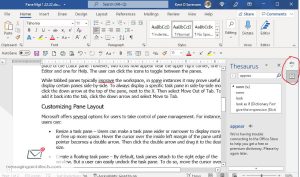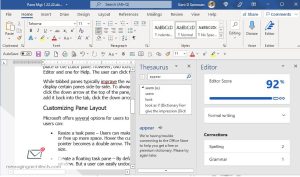Microsoft 365 apps deliver powerful features for creating complex presentations, documents, and spreadsheets. Tools such as the Editor, Design Ideas and Help, for instance, open task panes that appear side-by-side in the app window. In the past, multiple task panes displayed at once caused screen clutter, making it difficult to focus on the project at hand.
Now, however, with the introduction of tabbed panes, Microsoft has streamlined pane management, decluttering the screen. With this and other customization options, users gain control over their workspace, placing the focus back on the content.
Task Panes vs. Dialog Boxes
Microsoft uses task panes instead of dialog boxes for features that offer more complex options or that need to remain open. For example, a Word user may search Help for instructions on creating a custom table of contents. The Help task pane remains open on the screen, allowing the user to reference the instructions while completing the steps.
Tabbed Task Panes Free Up Screen Real Estate
However, task panes occupy significant space on the screen. And with two or more task panes open at once, the panes may obscure a large part of the slide or document page. Tabbed panes solve this problem.

For instance, when a Word user opens the Editor to check grammar, the Editor task pane appears on the right edge of the window. If the user also opens the Help pane, it displays in place of the Editor pane. However, two icons now appear near the upper right corner, one for Editor and one for Help. The user can click the icons to toggle between the panes.

While tabbed panes typically improve the workspace, in some instances it may prove useful to display certain panes side-by-side. To always display a specific task pane in side-by-side mode, click the down arrow at the top of the pane, next to the X. Then select Move Out of Tab. To add it back into the tab, click the down arrow and select Move to Tab.
Customizing Pane Layout
Microsoft offers several options for users to take control of pane management. For instance, users can:
- Resize a task pane – Users can make a task pane wider or narrower to display more text or free up more space. Hover the cursor over the inside left margin of the pane until the pointer becomes a double arrow. Then click the double arrow and drag it to the desired size.
- Create a floating task pane – By default, task panes attach to the right edge of the window. But a user can easily undock the task pane. To do so, move the cursor over the title bar of the task pane until it becomes a four-headed arrow. Then click and drag the pane to the desired location and resize as necessary.
- Re-dock a floating task plane – To send a floating task pane back to the edge of the app window, just double-click the task pane title bar.
Getting the Most Out of Microsoft Products
Microsoft constantly updates its products, adding new features to improve productivity, strengthen security and promote creativity. In fact, the tool your organization needs to solve a business problem may already exist.
The Microsoft experts at Messaging Architects have spent years helping their customers tap into the possibilities at their fingertips. They help organizations configure Microsoft for optimal use, from navigating email migrations to tailoring data security to meet specific needs.






